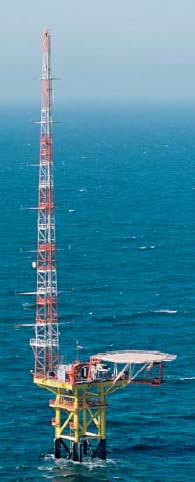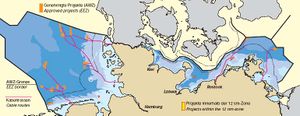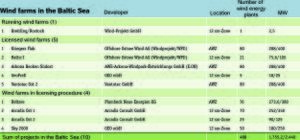Preparation of offshore wind farm development in Germany
Contents
- 1 Introduction
- 2 Frame conditions
- 3 Expansion targets in Germany
- 4 Economic aspects
- 5 Implementation of the Government’s offshore strategy
- 6 Actual status
- 7 Problems in setting up wind farms in the German EEZ
- 8 Solutions for goal achievement
- 9 Conclusion and outlook
- 10 References
- 11 Further useful Links
Introduction
The initiation or expansion of offshore wind farms represents a good development opportunity of many nations located at coasts. Especially in Denmark, Ireland, Sweden, the Netherlands and Great Britain wind energy plants offshore contribute to energy supply. Also other countries like France, Sweden, United States, China, Spain and Germany have announced their offshore wind power development plans. The increase of wind energy contributes to climate protection, sustainable development, economic growth, technical development and will boost significantly the export potential. Another driving factor for wind farm development in the sea is the aim of creating jobs, especially in structurally weak regions such as Lower Saxony, Schleswig-Holstein and Mecklenburg-Western Pomerania. Germany expects 20,000 additional jobs (Bundesministerium für Umwelt, Naturschutz und Reaktorsicherheit, 2007).
The political date of birth of the offshore wind energy was in March 2000 with the implementation of the Renewable Energy Sources Act (German: Erneuerbare Energiengesetz - EEG)[1]. The act is a support instrument for the expansion of renewable energies and aims a sustainable energy system. It has regulated for the first time feed-in-tariffs for offshore wind farms in the German coastal zone and the exclusive economic zone (EEZ) in the North and the Baltic Sea.
Frame conditions
According to the United Nations Convention on the Law of the Sea, UNCLOS (German: Seerechtsübereinkommen) nations are allowed to use areas up to 200 nautical miles in their exclusive economic zones for the construction of wind energy plants. By offshore wind turbine is meant any turbine that is located at least three nautical miles from the coastline. In the sea wind speed is much higher than on land and open space is available to a large extent. The North Sea exhibits adequate conditions as it belongs to the wind richest regions in the world. The wind blows in more than 90 % of the time with a speed of 4 meter per second (German Energy Agency, dena).
Expansion targets in Germany
The Federal States of Germany intend, according to the Renewable Energy Sources Act, to promote the share of renewable energies with the goal of generating at least 12.5 % of Germany's electricity needs from renewables by 2010, and at least 20 % by 2020. To ensure a sustainable energy extraction in the future, the further development of offshore wind farms in the North and Baltic Sea is one important part of the strategy.
To begin with the commercial construction of wind energy farms in the German waters in the period between 2008 and 2010 has high priority. By 2011 the installation of an output of about 1,500 MW shall be started which seems to be a realistic estimation provided that needed resources such as installation vehicles are available. By the end of the year 2015 an output of at least 3,000 MW shall be reached and by the year 2020 at least 10,000 MW. In this way a growing market will be initiated. The contribution made by offshore wind power is expected to rise by 2030 to an output of 20,000 to 25,000 MW. The potential annual electricity yield from offshore wind farms is estimated at 85 to 100 TWh, accounting for approximately 15 % of Germany’s electricity consumption in the reference year 1998 (Bundesministerium für Umwelt, Naturschutz und Reaktorsicherheit, 2007).
Economic aspects
The installation of an offshore power plant and its connection to the grid is a complicated process that demands high investment cost in the beginning. The investors of wind farms need labour force, wind turbines, steel, concrete, cables, transport and logistics. The investment costs amount about more than hundred million Euro for a single wind farm. For that reason only wind farms with an output of more than 100 MW are profitable.
One concern is the cost-effective use of offshore wind power which is linked to the Renewable Energy Sources Act (EEG). It defines the so called feed-in-tariffs. The basic idea is to grant wind farm operators a fixed payment for 20 years to ensure an economic operation of the plants. The fee that is paid for the electricity depends on the date of commissioning. For newly installed plants the refund decreases annually. At time electricity from offshore wind farms is guaranteed a feed-in tariff of 9.1 cents/kWh, provided the plants commenced operation prior to the end of 2010. In other countries such as the Netherlands or Great Britain 15 cents/kWh are paid or national investment grants are given.
Implementation of the Government’s offshore strategy
To achieve the targets formulated by the government, Germany follows a strategy consisting of mainly tree parts. First there is a need for optimizing the legal framework conditions. Then it is waited for the first results of the test field (Fino 1) [2] next to the island of Borkum in the North Sea. Moreover the German Environment Ministry is promoting research projects from its renewable energy research programme to accompany the development of offshore wind power use (Bundesministerium für Umwelt, Naturschutz und Reaktorsicherheit, 2007).
The “Strategy of the German Government on the use of Offshore wind energy” [3]published in 2006 aims to follow a step-by-step process during the next three decades.
1. Preparation phase 2001-2006 - MW 2. First expansion phase 2007-2010 2,000 – 3,000 MW 3. Additional expansion phases 2011-2030 20,000 – 25,000 MW
For improving the acceptance, gathering information and gaining experiences, the offshore wind energy foundation (“Stiftung der deutschen Wirtschaft zur Nutzung und Erforschung der Windenergie auf See") [4]has been founded. Members are manufacturers of wind energy plants, planners, energy supply companies, banks, insurance companies, several associations, engineer firms and the federal states in northern Germany. They initiated a test and research platform in the area Borkum West in the North Sea. The data gained at the platform Fino 1 are the basis for the development of scientific and technological standards for the approval process. In addition these data are needed for the investigation of technical, ecological and marine issues. Since September 2003 from this platform data on meteorology (wind speed, temperature, humidity, air pressure), oceanography (oxygen content, waves, water level and stream profiles) and biology in the German bight are collected systematically. Since 2006 a second platform, named Fino 2 works in a similar way. It is located in the Baltic Sea north of the island of Rügen.
In terms of the selection of locations for wind farms and cables the federal regional planning act (Raumordnungsgesetz, ROG)[5] provides regulation tools in the German EEZ. The law is used to bring different demands in coast utilisation (e.g. shipping, military use, mari culture) and ocean exploitation (e.g. fishing, drilling for oil and gas) in order. It helps to identify suitable areas which can be determined as priority areas for energy exploitation. That excludes other activities in the same area which would hinder wind farm projects.
Actual status
According to the Annual Report 2006 of the Hydrographic Agency (BSH) (pdf-file in German) [6]it is planned to set up 34 offshore wind energy farms in the North Sea and 6 in the Baltic Sea. Up to now, 15 wind energy farms with 1097 wind energy plants have been licensed. So far only two isolated offshore plants with an output of 4.5 MW and 2.5 MW have been built in the vicinity of the coast near Emden and Rostock. The first wind farms are due in 2008 and 2009. The Infrastructure Planning Acceleration Act guarantees the grid connection for all offshore plants for which construction has commenced prior to 31st December 2011.
In autumn 2006 the deployment of the test field Alpha ventus [7] has been launched, financed by EWE [8], E.ON Energie [9] and Vattenfall Europe [10] as well as the manufacturers of the wind energy plants Multibrid and REpower Systems. The test field embraces six 5 MW wind energy plants of the tripod–type that will be installed by end of September 2008.
Problems in setting up wind farms in the German EEZ
In contrast to other countries in Europe Germany is not allowed to construct the wind energy farms in the coastal waters due to protected areas in the Wadden Sea. The German Government’s strategy aims to exclude wind energy facilities from national parks [11] and NATURA 2000 areas [12]. For that reason long distances to the coast (30-100 km) and sea depths of up to 40 m must be considered. That means a major challenge for the foundations, the encapsulation of the gondola and the materials. Since offshore wind energy plants can be compared only partly with wind turbines on land, a lack of experience in technical issues hinders the progress. Many ideas for construction types such as tripod, monopole, jacket etc. have been developed but at time there is no information in view of applicability and in shipping safety of the plants.
Additionally, long distances to the shore pose major challenges. The transportation of large quantities of electricity to the mainland is also very labour-intensive, as is the associated maintenance and servicing work.
Another problem in Germany refers to different responsibilities when licensing a wind plant and the attached cable. Whereas the wind power plant itself in the EEZ is licensed by the BSH and the national law, the underground cables lie within the coastal waters (12 nautical mile zone) where the Federal States with their federal laws are in charge. Up to twelve administrative facilities have to submit their license. Due to this complicated process it can take 10 years from planning stage to electricity production.
The licensing process of the cables is still too complicated because of lacks in the federal regional planning act (Raumordnungsgesetz, ROG) that gives no instructions for an adequate planning procedure. Additionally there are no legal and economic basics for a preferable bundling of cables for different wind farms.
Another reason that offshore wind farms are not operating yet is the dramatic increase of the prices for steel and cupper since 2002. That results in exorbitant costs of the prospected wind farm. This explains the cautious behaviour of investors who prefer to wait for lower prices.
The instructions for licensing wind energy plants in the EEZ specified by the Marine Facilities Ordinance (German: Seeanlagenverordnung)[13] ascribes Environment and Nature protection high significance. But definite rules are missing by now to protect the environment in a better way and to ensure legal security for investors.
Significant restraints will occur, when wind farms are connected to the grid and electricity is fed in. The recent grid is not able to deal with the future electricity amount.
Solutions for goal achievement
That offshore wind farms have not yet been installed, has its reason lastly in uncertainties due to missing knowledge and experience. In general various surveys should be carried out in future to gain experiences with offshore wind farms in the location of the German EEZ. Aims are to lower cost of electricity production, increase yields, ensure reliable operation of the wind farms, advance the level of grid integration, and organise the expansion of offshore wind power in an eco-friendly way that does not impinge on nature (Bundesministerium für Umwelt, Naturschutz und Reaktorsicherheit, 2007). All this gives reason for research in the field of offshore wind power. The investigations will help to eliminate present barriers.
Considerable uncertainties exist how intensive the wind energy plants will effect on wildlife. Studies of the marine species and their behaviour in the vicinity of offshore wind energy plants must be pursued. Furthermore the influences of each possible construction type must be regarded and assessed. The same refers to shipping safety in combination with wind energy plants. Though the wind farms should not be constructed in water ways with high shipping frequencies, the risk of collision can not be excluded.
The enhancement and stabilization of the national grid is an absolutely necessary measure because it is not able to deal with high energy amounts and to store energy. The grid study (in German) [14] of the German Energy Agency (dena) [15] from 2005 calls for a rapid expansion of transfer capacities. Part 2 of the grid study will examine the integration of renewable energies into Germany's extra-high voltage grid and will provide technically innovative solutions. The new Renewable Energy Sources Act (EEG) forces grid operators to supply sufficient transfer capacities.
Conclusion and outlook
Due to these obstructions the development goal up to 2010 is not achievable. But the Federal Ministry for the Environment, Nature Conservation and Nuclear Safety (BMU) [16] states there is no doubt that long-term goals can be reached and that challenges occurring nowadays are solvable.
As the development of wind energy on land the achievement of the goals of the offshore wind energy market is only possible when having the right economic frame conditions for investors. How fast the further development will be depends on the speed of the creation of these conditions and the solution of relevant problems. Highly important is also the law amendment of the Renewable Energy Sources Act in the year 2008 that will fix new feed-in-tariffs.
A significant delay of the offshore development will cause a significant risk that offshore wind farms will be realised with minor participation of the German economy but with high participation of foreign companies.
References
Bundesamt für Seeschifffahrt und Hydrographie (BSH) (2006): Jahresbericht. Hamburg und Rostock http://www.bsh.de/de/Produkte/Infomaterial/Jahresbericht/Jahresbericht2006/Jahresbericht2006.pdf
Bundesministerium für Umwelt, Naturschutz und Reaktorsicherheit (2007): Offshore wind power deployment in Germany. http://www.bmu.de/files/pdfs/allgemein/application/pdf/offshore_wind_deployment_de_en.pdf
Umweltbundesamt (2007): Entwicklung einer Umweltstrategie für die Windenergienutzung an Land und auf See Kurzfassung: Ergebnisse und Handlungsempfehlungen. Dessau. http://www.umweltdaten.de/publikationen/fpdf-k/k3242.pdf
Windenergie-Agentur Bremerhaven/Bremen e.V. (2007): Offshore Windenergie. Der Wind, das Meer und die Zukunft der Energieversorgung. Das Magazin. http://www.windenergie-agentur.de/deutsch/PDFs/OffshoreMagazin_reduced.pdf
Further useful Links
Federal Ministry of Ecucation and Research – Coastal Futures information portal http://www.coastal-futures.de/ Federal Ministry for the Environment, Nature Conservation and Nuclear Safety (BMU) http://www.erneuerbare-energien.de Federal Maritime and Hydrographic Agency (BSH) http://www.bsh.de Federal Environmental Agency (UBA) http://www.umweltbundesamt.de Federal Agency for Nature Conservation (BfN) http://www.bfn.de German Energy Agency (dena) http://www.offshore-wind.de Offshore Wind Energy Foundation http://www.offshore-stiftung.de German Wind Energy Association (BWE) http://www.wind-energie.de/de/themen/offshore/ Bundesverband der Windindustrie http://www.deutsche-windindustrie.de/fakten/offshore/ German Engineering Federation (VDMA) http://www.vdma.org/windenergie Competence Network Rostock http://www.offshore-energies.de wab - Windenergie Agentur Bremerhaven/Bremen e.V http://www.windenergie-agentur.de CEwind - Center of Excellence http://www.cewind.de windcomm - Netzwerkagentur Schleswig-Holstein http://www.windcomm.de Forwind - Center for Wind Energy Research http://www.forwind.de Pushing Offshore Wind Energy Regions http://www.offshore-power.net
Please note that others may also have edited the contents of this article.
|




